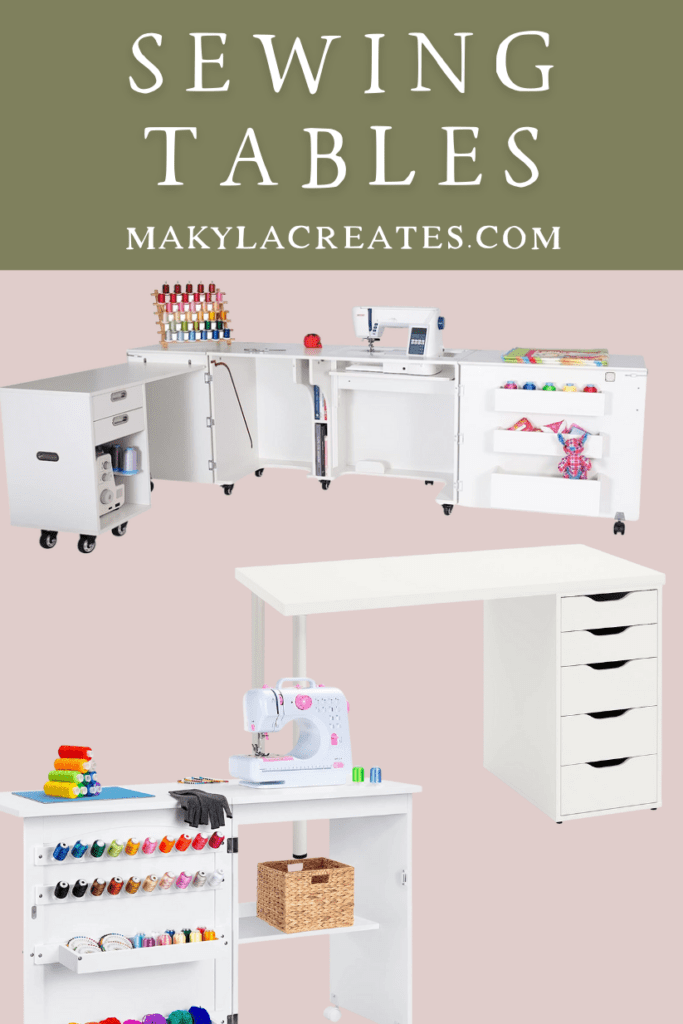If you have a passion for sewing, having a functional sewing machine table with enough space to cut and sew on can really help speed up the process and make it more enjoyable. There are so many different options, from portable sewing tables to DIY ideas.
A sewing table is great for laying out your fabric and cutting out patterns, plus it’s a perfect place to set up your sewing machine. And if you need extra storage space for your sewing tools, there are many tables with functional space to keep your things organised.
In this blog post, we’ll explore all the different types of sewing machine tables available and help you find the perfect option for your space.

As an Amazon Associate, I earn from qualifying purchases. Read my full disclosure here.
1. Portable & Adjustable Sewing Tables
If you love the freedom to sew wherever you want, then a portable and adjustable sewing table could be perfect for you!
These tables are designed to be lightweight and easy to move around, so you can set up your sewing equipment wherever you’d like. In Winter, my office can get quite cold, so to save on energy costs, I use a portable sewing table to set up in my living room.
They’re effortless to transport and store with features like foldable legs and wheels. Plus, they’re great if you don’t have a lot of space to set up a permanent sewing space.
If you plan to attend sewing classes or workshops, a portable table makes this super easy.
When shopping for a portable sewing machine table, consider the following features:
- Sturdy – look for a table made from durable materials, such as steel or aluminium, to ensure stability during your sewing sessions. A sturdy construction is vital to prevent wobbling or shaking during your sewing sessions.
- Adjustable Height – a table with adjustable height settings allows you to customise the table’s height to match your comfort level and sewing techniques.
- Adjustable Tabletop – an adjustable tilting tabletop lets you work on different sewing techniques, such as quilting or embroidery, easily.
- Extra Table Space – for larger projects, it can be handy to have an extra tabletop that can fold out. This is especially useful for quilting projects.
- Storage Options – some portable sewing tables have built-in storage compartments or baskets, providing convenient space to store your sewing supplies and accessories.


2. Cabinet Sewing Tables
A cabinet sewing machine table offers excellent organisation and efficiency if you have a dedicated sewing room or a larger space.
These tables have built-in storage cabinets and drawers, providing ample space to store your sewing machine, fabric, threads, and other essential supplies.
Cabinet sewing tables are designed to keep your workspace tidy and clutter-free, making it easier for you to focus on your sewing projects.
Consider the following factors when choosing a cabinet sewing table:
- Size and Function – Ensure the table’s dimensions fit comfortably in your sewing area. Consider the layout of storage compartments and drawers for your sewing tools and materials.
- Sturdiness – Look for a table made from high-quality materials, such as hardwood or engineered wood, to ensure durability and stability.
- Ergonomics – Pay attention to the table’s height, ensuring it provides a comfortable position to avoid strain or fatigue during long sewing sessions.



3. DIY Sewing Tables
If you enjoy getting creative and want a sewing area just right for you, making your own sewing table could be the way to go. Building a sewing table yourself means you get to make it exactly how you want it, and it can be a satisfying and affordable project.
When embarking on a DIY sewing table project, consider the following tips:
- When planning your sewing machine table, it’s important to keep a few things in mind to ensure it’s perfect for your space and needs. First, think about the design and measurements you want. It’s important to consider the size of your sewing machine and any extra features you may want, as well as any storage needs you have.
- Once you have a plan, gather all the necessary materials and tools. This could include a premade tabletop, desk legs, screws, a drill, a saw, sandpaper, and paint or finish.
- Next, it’s important to pay attention to ergonomics. Make sure the height of your table is comfortable for you to work at and that the surface is sturdy enough to hold your machine and projects.
- Finally, consider incorporating storage solutions into your design. Adding drawers, shelves, or bins can help keep your supplies organised and easily accessible.
Another DIY sewing machine table option is to use a kitchen island or two together for a larger table space. These have excellent built-in storage options like the Ikea one below.

You could also customise your space with the Ikea Alex desk range. I have used this range to create a long functional sewing table space in my office. The drawers offer amazing storage for all my sewing tools, patterns, and fabric.

Sewing Machine Tables Conclusion
To create a comfortable, organised, and efficient workspace for your sewing hobby, it’s important to find the perfect sewing table. You can choose from various options such as portable and adjustable sewing tables for flexibility, cabinet sewing tables for organisation, or even DIY sewing tables for a personalised touch. To make the best choice, consider your specific needs, available space, and budget. Investing in a suitable sewing machine table can enhance your sewing experience and give you a dedicated space where your creativity can flourish.